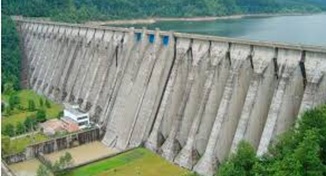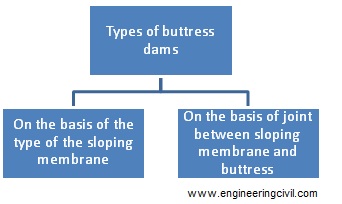What are buttress dams?
A buttress dam consists of water retaining sloping membrane or deck on the upstream which is supported by a series of buttresses at right angles to the axis of the dam. The upstream water retaining sloping membrane may be in the form of a reinforced concrete slab or a series of arches or thickened buttress heads. At the upstream end a cutoff is provides to prevent or reduce the seepage of water.

Buttress dams [1]
Buttresses are?
Buttresses are the thin walls of triangular profile shape with a characteristic sloping upstream face. They are usually spaced at equal intervals along the length of the dam and are supported either on a continuous mat foundation or on a separate spread footing.

Classification based on the type of sloping membrane
On the basis of sloping membrane the buttress dams may be classified as follows:
I. Ambursen type/ Flat slab/Deck slab type buttress dams
II. Multiple arch type buttress dams
III. Multiple dome type buttress dams
IV. Bulk head /Massive head type buttress dams
Ambursen type/ Flat slab/ Deck slab type buttress dams
The deck slab or flat slab type buttress dams are also known as Ambursen type buttress dams in honor of Nils F Ambursen who in1903 built the first flat slab type of buttress dam. In this type of buttress dam the sloping membrane or deck consists of a reinforced concrete slab supported by a series of buttresses. The inclination of the deck slab is kept between 35? to 45? with the horizontal. In order to provide a wide base for the slab supported by the buttress the upstream end of the buttress where it joins the slab is usually made wide by providing haunch or corbel.
The deck slab type buttress dams can be subdivided into three types:
• Simple deck slab type buttress dams
In this type of buttress dam the deck slab is not rigidly attached to the buttresses but it is in the form of a simply supported slab which remains in contact with the buttress tongue. The joint between the slab and buttress tongue is filled with bituminous mastic or asphaltic putty or some flexible joint compound.
• Fixed or continuous deck slab type buttress dams
In this type of buttress dam the deck slab is cast monolithic with the buttress and it is in the form of a continuousslab. Thus in this case the reinforcement is provided both on upstream and downstream faces of the slab because of reversing bending moments and there is a possibility of upstream reinforcement being corroded. In this type of dam the deck slab is relatively thin
• Cantilever deck slab type buttress dams
In this type of buttress dam the deck slab is cast monolithic with the buttress in such a manner that the deck slab overhangs on either side of each buttress as cantilever.
In addition to the above noted deck slab type buttress dams, there are two more types of these dams as following:
• Columnar type buttress dams: This type of dams consist of continuous flat slab of reinforced concrete supported on a number of inclined columns instead of buttresses. The columns are also reinforced and are stiffened by a two-directional system of struts.
• Truss type buttress dams: IN this type of buttress dams the reinforced-concrete deck slab is supported on a number of reinforced-concrete trusses instead of buttresses.
Multiple –arch type buttress dams
In this type of buttress dam the sloping membrane or deck consists of a series of reinforced-concrete arches supported by a number of buttresses. The upstream face of the dam is usually inclined at 45.The arches are cast monolithic with the buttresses.
Multiple-dome type buttress dams
In this type of buttress dam the sloping membrane or deck consists of a series of reinforced-concrete domes supported by a number of buttresses
Bulk head /Massive head type buttress dams
The main feature of this type of dam is, there is no separate water retaining member is provided and the water retaining member is formed only by enlarging the upstream end side of the buttress. Thus the dam is made with a series of buttresses and massive heads placed side by side.
The massive head type buttress dams may be further subdivided on the basis of the shape of the buttress head into the following 3 types:
- Round head buttress dams
- Diamond head buttress dams
- Tee head buttress dams
Classification based on the joint between the sloping membrane and buttresses
On the basis of the joint between the sloping membrane and buttresses the buttress dams may be classified in the following three categories
- Rigid buttress dams
Here, the sloping membrane or deck is constructed monolithic with the buttresses. As such for these dams the influence of foundation settlement, temperature variation and shrinkage of concrete are significant and provisions have to be made for these in the design.
- Articulated buttress dams
Here, the sloping membrane or deck is not constructed monolithic with the buttresses. As such dams are flexible and hence the influence of settlement of foundation, temperature variation and shrinkage of concrete are not significant for these dams
- Intermediate or semi-rigid buttress dams
The intermediate or semi-rigid buttress dams are in between the rigid and articulated buttress dams. Thus these dams eliminate the undesirable rigidity but also do not possess high degree of articulation or flexibility.
Advantages of buttress dams
- A buttress dam is less massive than a comparable gravity dam. The buttress dam can be constructed even on a relatively weak foundation on which the gravity dam may not be constructed.
- The spacing of the buttresses may be adjusted to utilize zones of good foundations
- Buttress dams can be designed to accommodate moderate amounts of foundation movement without serious damages, thus it can be built in the soil with differential settlements.
- The amount of concrete required for a buttress dam is about 1/3 to ½ of the concrete required for a gravity dam of the same height.
- Access is possible to the back of the upstream face of the dam and to the foundation between buttresses for periodic inspection and for subsequent grouting and drilling pressure relied holes, if required.
- The uplift pressure acting on a buttress dam is considerably less which leads to economy in concrete and overall stability of the dam.
- The upstream face of a buttress dam being considerably inclined a large vertical component of water pressure is developed which contributes to overall stability of the dam and saves concrete.
- The power house, switch yard etc., can be located between the buttresses thus saving some cost of construction.
Disadvantages of buttress dams
- Skilled labor requirements and the shuttering to concrete ratio are greater for buttress dam than for a gravity dam. This may lead to higher unit rate of concrete.
- Deterioration of the upstream surface of relatively thin reinforced-concrete deck slab or arch of a buttress dam has more serious effects on the stability of the dam,
- The number of water seals to be provided and maintained for a buttress dam is usually more than for other dams.
- The foundation stresses being higher, either sound rock foundation is necessary or spread footings, or continuous mat may be required to be provided which will increase the cost of construction.
- The saving due to reduction in the quantity of concrete will also be to some extent offset by the requirement of heavy reinforcement for relatively thin members of a buttress dam
- The buttress dams are more susceptible to willful damage (by sabotage or enemy action) than solid gravity dams.
Reference
[1] A. Abdulamita, S. Demetriua, A. Aldeaa, C. Neagua, D. Gaftoia., Ambient vibration tests at some buttress dams in Romania, X International conference on structural engineering , Procedia Engineering 199 (2017) 2196–2201
from Civil Engineering Portal https://ift.tt/3dAs1Ze


